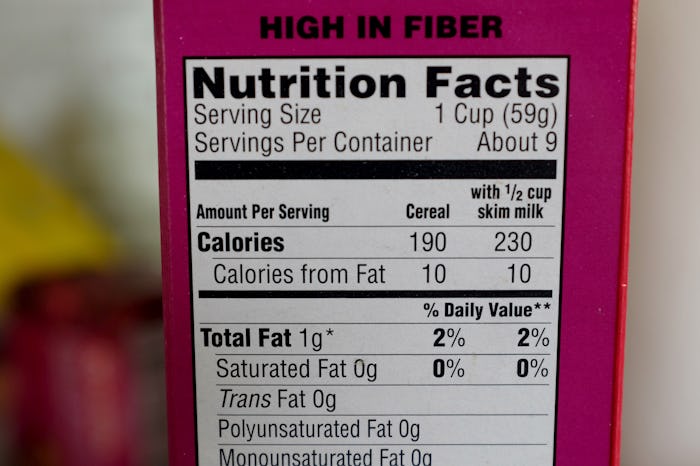
What Does The New Nutrition Label Mean? A Lot Less Math, At Least
On Friday, Michele Obama unveiled the Food and Drug Administration's new nutrition label. The new nutrition labels means that there are eight differences you can try to spot Where's Waldo? style while you stare at the back of your snack while you pretend to watch your kids soccer match on a weekend morning. They're actually pretty obvious. Now, there are updated serving size amounts and they make it clearer as to how many servings are in each package or container. Because who knows what 2/3 of a cup means when it comes to granola?
Calories are listed in a larger font, there are updated daily values, a new footnote about what those daily values actually mean, a change in daily nutrients, and the label now includes a list of added sugars. There's also a "dual column," so you can see how much of everything is in a serving and an entire package.
The new serving sizes now are supposed to reflect what "most people" actually consume in one sitting. So, with beverages, a 12 oz. bottle and a 20 oz. bottle are both one serving now. If you're counting juicebox calories, it's more of a one-to-one calculation with the new label. When you add the new information about added sugars and a larger calorie count, officials are hoping that more consumers will know exactly what they're drinking. And that it will encourage manufacturers to produce healthier products, according to The New York Times.
It's actually a much clearer way of presenting the information. If you're counting calories, at least, you won't be able to avoid the numbers now. Of course, the sugar people are not happy about the new reporting requirements. Pushback from the Sugar Association led to the added sugars line still being reported in grams as opposed to teaspoons, which is easier for most Americans to picture. But the FDA still counts the addition of reported sugars as a win. Dr. David Kessler, the former F.D.A. commissioner, told The New York Times that "They got this right. This will affect people’s lives."
Most food manufacturers have until the end of July 2016 to comply with the new labelling requirements, though smaller manufacturers that make less than $10 million a year in food sales will get an extra year to do the required testing and labeling, according to the FDA.
It's very much a more practical way to present the information and updates nutritional information that has remained the same since the first labels were required in 1993. The new labels are all about how we eat now and the increased emphasis on sugars is a direct response to the growing obesity epidemic. FDA Commissioner Robert Califf, M.D. said in the official statement that, "The updated label makes improvements to this valuable resource so consumers can make more informed food choices – one of the most important steps a person can take to reduce the risk of heart disease and obesity."
The changes should be welcome to everyone — unless you've been making it a habit to hide from calorie counts.